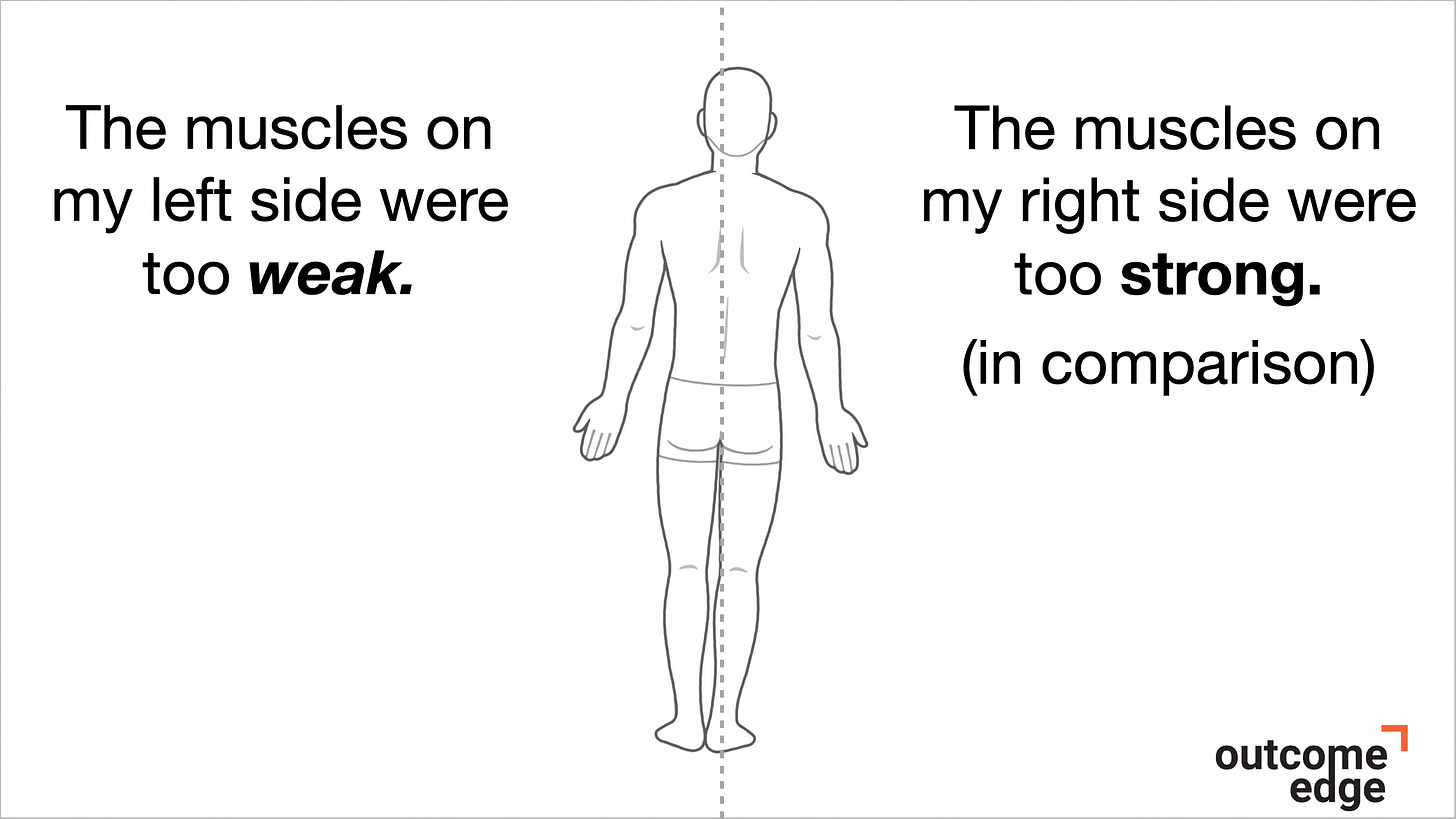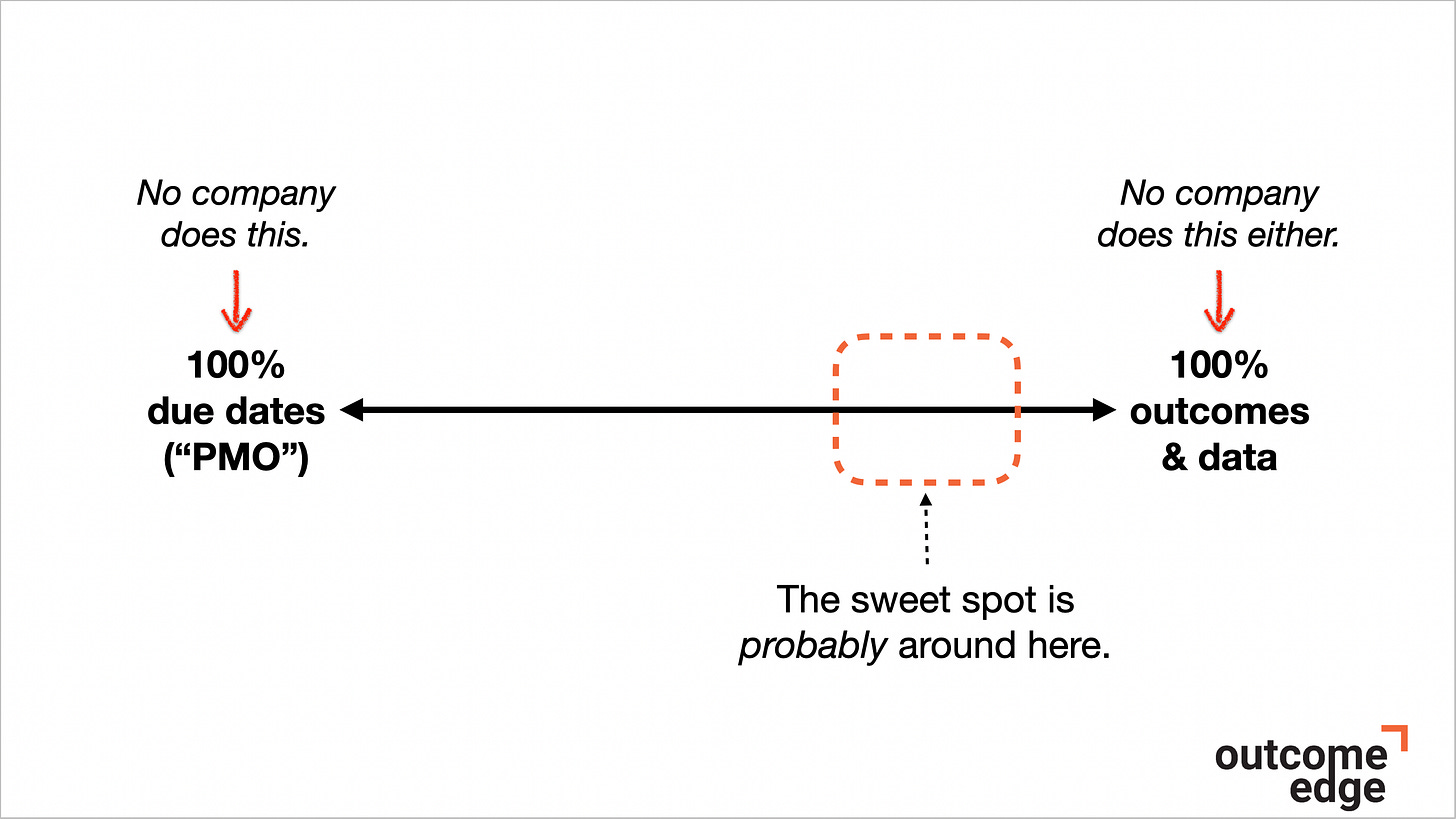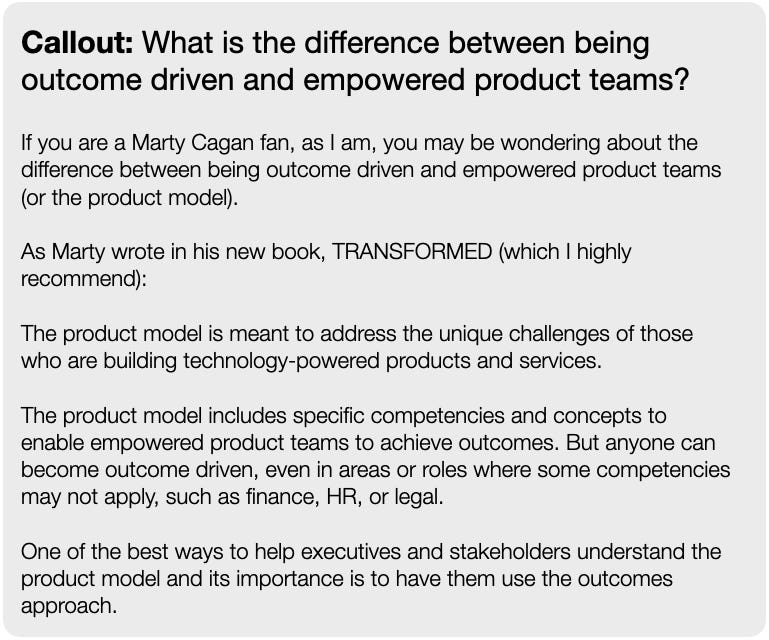It’s time to be outcome driven
Learn why most companies are not getting results from OKR and what you can do about it.
This post is also available in Portuguese.
You’ve probably already noticed—OKR is not a silver bullet.
It feels like everyone is using OKR. Unfortunately, most companies that tried to use OKR are disappointed with the results.
However, while OKR usually doesn’t live up to (often unrealistic) expectations, the underlying issues that create the demand for it are real.
Over the past ten years, I’ve talked to hundreds of companies about which problems they wanted to solve with OKR. The same 12 challenges appeared over and over, regardless of whether the organization used OKR or not.
I’d bet that you can relate to some of them:
Competitors are innovating faster than you are.
Employees don’t understand how their work contributes to the strategy.
People are not moving in the same direction. Teams often set conflicting priorities.
The organization has too many priorities and is spreading itself too thin.
The CFO is frustrated with the meager returns from technology investments.
A large portion of the budget is allocated to projects, but the organization can’t measure the outcomes of these projects.
Many OKRs (or goals) within the organization are project-based, such as “Launch the new website,” “Deploy the MVP,” or “Migrate 100% of the servers to the cloud.”
The organization often evaluates employees based on their ability to meet due dates. It doesn’t matter if they’ve helped the company or not.
The company has many dashboards, but people often don’t use data to guide day-to-day decisions or provide insights.
Employees are asking for more autonomy and a clear purpose.
Employees resist setting ambitious OKRs (or goals), admitting mistakes, or asking questions.
People don’t take ownership of their OKRs (or goals). People see them as a formality that doesn’t guide their day-to-day work.
If these challenges hit too close to home, don’t feel bad about it. It’s not your fault.
But you must do something about it.
OKR is a tool, not a silver bullet
Given all the disappointment with OKR, some people are looking for better alternatives.
But whether you choose to use OKR or any other technique, you have to understand that they are not silver bullets. They are just tools, and the results you get from any tool depend on how you use it.
As Benedict Evans points out, humans have a clear tendency when they get new tools:
There’s an old saying that when we get a new tool, we begin by making it fit the old way of working, and then we change the way we work to fit the new tool.
99% of people make OKR fit their old way of working. Like that popular definition of insanity, they keep doing the same thing over and over while expecting different results.
It’s no wonder so many are disappointed. And they will probably be disappointed by the next tool, too.
Trying to address those 12 challenges with OKR alone is like trying to heal a broken leg with an ice pack.
While OKR may help ease some symptoms if properly used—talk about a huge “if”—it is not enough to address the structural, deeper causes.
If you’ve completely lost faith in OKR, you may choose to use something else instead. But you must understand that replacing OKR with another tool is like buying a different ice pack. Alone, it won’t change much.
You have to address the deeper causes
This situation is similar to an experience I had with a physical therapist recently. She told me I had to unlearn the way I walked.
I had been dealing with severe back pain for years. Sometimes, the right side of my back would seize up, and I would be unable to move. That was not fun at all.
The leading cause was that the muscles on my left side were too weak, while the ones on the right side were too strong. This made me lean to the right while walking, standing, or sitting, creating a lot of pain.
You are also dealing with weak muscles
You and your organization are also dealing with weak muscles, starting with your “outcome muscles.” But what does that mean?
All organizations use two approaches to manage work, often without realizing it.
First, there’s the due dates approach, where the goal is to meet deadlines. If you work in a traditional company, you may know it by a different name: the PMO (project management office) approach.
Some people call this the output approach, but that can be a confusing term (see callout at the end of the article).
When we use the due dates approach, it doesn’t matter if our project made a difference or not. Our objective is simply to complete projects on time, on budget, and on scope.
Here, dates tell us if we’re successful.
The second approach is the outcomes approach, where the goal is to make a difference. As Marty Cagan once told me:
We all know that we do things and that some of those things make a difference while others do not. The outcomes approach is about focusing on the difference we are trying to make and not losing sight of it.
When we use the outcomes approach, our job doesn’t end when we complete projects. We have to test different options until we achieve the outcome. Delivering projects is important, but simply meeting deadlines is not the goal.
Here, data tells us if we’re successful.
All companies use both approaches to manage work, but your “outcome muscles” are probably too weak, while your “due date muscles” are too strong.
This weakness is making your organization lean heavily on the due dates approach. You are getting a due date overdose.
Companies have many dashboards, but most still manage work based on due dates. We often have something like the image below, where the organization unintentionally manages a large share of its investments using due dates.
More Outcomes, Fewer Dates™
There’s a “slogan” that represents the shift to outcomes, facilitating the dialogue about the new culture: More Outcomes, Fewer Dates™.
The core idea behind More Outcomes, Fewer Dates™ is to intentionally increase the “share” of our investments managed with outcomes and data over time.
We are not talking about zero dates but fewer dates.
It’s human nature to want to make everything binary: something is either completely good or completely bad. This desire to oversimplify things creates several misconceptions that we have to address.
Let’s start with the first one: the idea that you should have zero due dates.
Let me be clear: all organizations use both approaches to manage work. Unless you are a government agency in North Korea, you can’t survive by managing 100% of the work using due dates.
No organization manages 100% of its investments based on outcomes alone, either. There are always cases where we need to commit to dates, whether due to regulations, contracts, or events like Black Friday.
The solution is not to go to the extremes. The solution is to find the right balance. That doesn’t mean a precise 50/50 split, it means you have to choose the right approach for each context.
More Outcomes, Fewer Dates™ is about deliberately selecting the best approach for each situation. And to make it happen, we have to develop new muscles but also new mindsets.
Your weak muscles are not the only thing causing the due date overdose
There is an even another structural, deeper cause to your challenges: the know-it-all mindset, where we believe we have all the answers and have everything figured out.
The hallmarks of the know-it-all mindset are the phrases “This will obviously work, there’s no need for measuring,” “We know what we are doing,” and “We’ve always done it this way.”
When you catch yourself using phrases like those, it’s a sign that you’ve drifted into know-it-all territory. We all act as know-it-alls from time to time—more often than we realize.
When we fall into the know-it-all mindset, we implicitly assume our projects will be successful, as long as they’re on time and on budget. Delivering projects becomes synonymous with generating results, and we rely even more on due dates.
The know-it-all mindset is not only in people’s heads. It’s also deeply embedded in most organizations’ cultures and processes. You could say that we are dealing with structural know-it-all-ism, but I’m not even sure how to spell that.
Think about it: how many of your organization’s incentives reinforce the know-it-all mindset? How many processes assume that delivering projects means generating results? How often do you measure whether each project actually achieved the desired outcomes?
The due date overdose is creating a lot of pain
The overuse of due dates contributes to many of the 12 challenges we’ve seen in the beginning of the article.
Companies with weak outcome muscles struggle to measure the outcomes of their investments. That means they don’t know what’s working or not, leading to meager returns.
Paraphrasing John Wanamaker, half the money I spend on projects is wasted. The trouble is, I don’t know which half. And that may be an understatement, as some analysts say the waste is much higher.
Know-it-all executives often treat employees as order-takers who simply deliver projects assigned to them. This mindset drastically reduces their empowerment and kills innovation—critical factors for achieving outcomes.
The due dates approach often makes employees feel like hamsters, running nonstop on their wheels but never getting anywhere. This robs them of their sense of purpose, hurting their engagement and retention.
And when people can only see projects and due dates, they struggle to understand the strategy or how they contribute to it.
Finally, the overuse of dates also builds the wrong culture: a culture that values shipping projects, not making a difference. Hitting dates is easier than achieving outcomes.
The best companies understand all the problems caused by the due date overdose and the know-it-all mindset. That’s why they adopt a completely different mindset for leading people, managing work, and developing products.
Today’s most successful companies are outcome driven
Today’s winning organizations like Amazon and Apple are outcome driven1.
Being outcome driven means being motivated by the desire to make a difference, not just complete projects. It means intentionally focusing on the outcomes you want to achieve instead of going through the motions.
Outcome-driven companies define success based on outcomes, but they don’t stop there. They also align the whole organization toward achieving these outcomes: all decisions, actions, processes, and practices.
The outcome-driven mindset requires deliberate effort and an environment that supports it
Humans are not naturally wired to be outcome driven. Left to their own devices, our brains tend to fall into the know-it-all mindset, the same way we tend to fall into doom-scrolling on Twitter or Instagram.
We didn’t evolve to be outcome driven, the same way we didn’t evolve to cope with the world of smartphones and social media.
Anyone can adopt the outcome-driven mindset, but it requires conscious and deliberate effort.
It’s not just about individual commitment, though. The organization also has to have mechanisms and a culture that supports the outcome-driven mindset. But most companies don’t have that.
Most organizations are not ready for outcomes
The outcome-driven mindset is a fundamentally different way to lead people and manage work. It doesn’t fit most organizations’ existing capabilities, processes, or cultures. It also doesn’t match most individuals’ existing skills and mindsets.
This leaves us with two options: if you want to say you are outcome driven, you can simply water the concept down to fit your old way of working.
But if you want to benefit from being outcome driven, you must change your organization’s culture and ways of working at a fundamental level.
It starts by developing those weak muscles we’ve been talking about.
Leaders and employees need to develop the necessary skills. Training is only part of the solution. You also have to change how people work so they can apply those new skills. As they say, if you don’t use it, you lose it.
The organization also has to develop the necessary capabilities. For example, does the company collect all the data needed to know if its investments are making a difference?
Developing your weak muscles is not enough, as it wasn’t enough for me.
Just like I had to unlearn how I walked, you have to unlearn how you work.
Senior leaders and individual contributors have to unlearn the mindsets, behaviors, and methods that contributed to this situation.
The organization must also abandon any practice that reinforces old behaviors. If a process, workflow, metric, or incentive reinforces old behaviors, you must scrap it.
You can make progress in gradual steps
After reading this article, some may feel that building an outcome-driven culture is impossible, while others may think that it’s easy. This is another one of those cases where the answer is not in the extremes, but somewhere in between.
Building an outcome-driven culture is a journey, but you can make progress in gradual steps. You won’t get there overnight, but it’s possible to make improvements every quarter.
What to read next
I'm writing more articles about how to build outcome-driven organizations and get results from OKR.
I want this post to act as a “hub” pointing you to what to read next.
Here are the articles I've published so far, grouped in different topics.
Understanding outcomes
There’s a lot of confusion about what outcomes really are. The articles below can help clarify that.
Develop your outcome muscles by learning to separate outcomes from projects and also from project metrics.
Put investments in two buckets: OKR + Projects.
Is your company using OKR only on paper?
It's time to abandon old mindsets and behaviors.
Define outcomes before projects.
Using the Five Whys technique to shift from projects to outcomes.
Outcome-driven leadership
At its core, being outcome driven is about leadership. Nothing will change unless leaders commit to adopting a different way to lead. The two articles below talk about what that means.
High-performance teams require management that is just right, not too much, not too little.
Outcome-driven leaders view organizations as something they can design, test, and improve. Like a product.
I’d love to hear from you
Do you have any questions or thoughts about this article? Any suggestions for future topics?
Feel free to leave your comments below or email me. And if you find this article helpful, please share it with others.
Acknowledgment
Special thanks to Marty Cagan, Itamar Gilad, Ian Harvey, and André Carregal for reviewing drafts of this article, and to Carlos Accioly and Melissa Suzuno for helping me edit and develop it.
If you’re finding this newsletter valuable, share it with a friend, and consider subscribing if you haven’t already.
No organization is perfect. Even the best companies fall into the know-it-all mindset from time to time. They also may have some know-it-all executives running parts of the company.
When I say that an organization is outcome driven, I’m talking about the primary culture inside the company.














Felipe, your writings are so clear. I really appreciate, that I can access this kind of wisdom.
It is an eye-opening article about OKRs Felipe Castro.
Among so many good observations: "While OKR may help ease some symptoms *if* properly used—talk about a huge 'if'—it is not enough to address the structural, deeper causes."
This is where an "impact value agile" approach strengthens our ways of working by combining OKRs and Agile. This can help us make a difference in IT and feel better about delivering more value for our efforts.
My comments here https://www.linkedin.com/posts/hugovega_okr-agilemethodology-valuedelivery-activity-7242787427688312832-v5k9?utm_source=share&utm_medium=member_desktop
Well done FelipeCastro.
Hugo